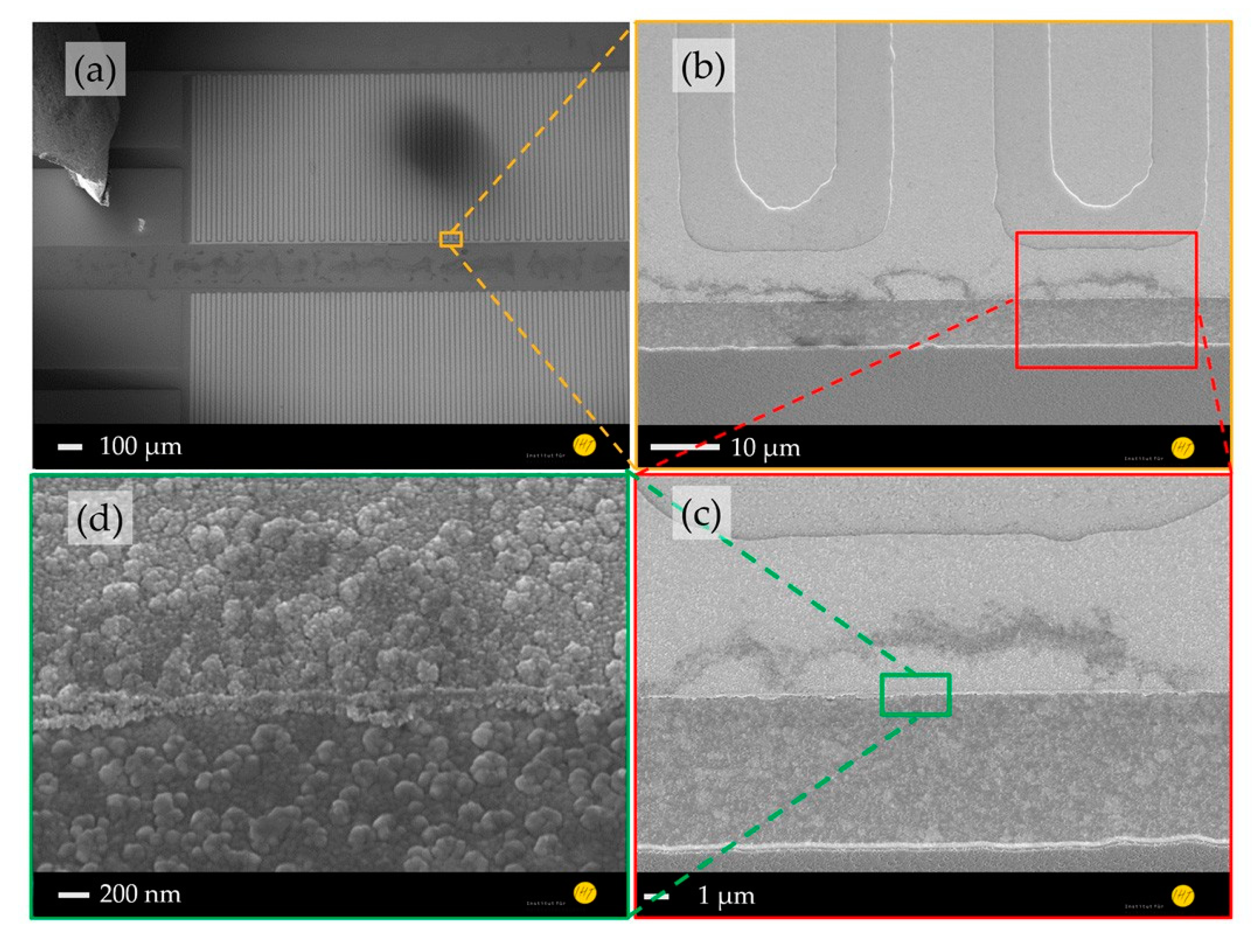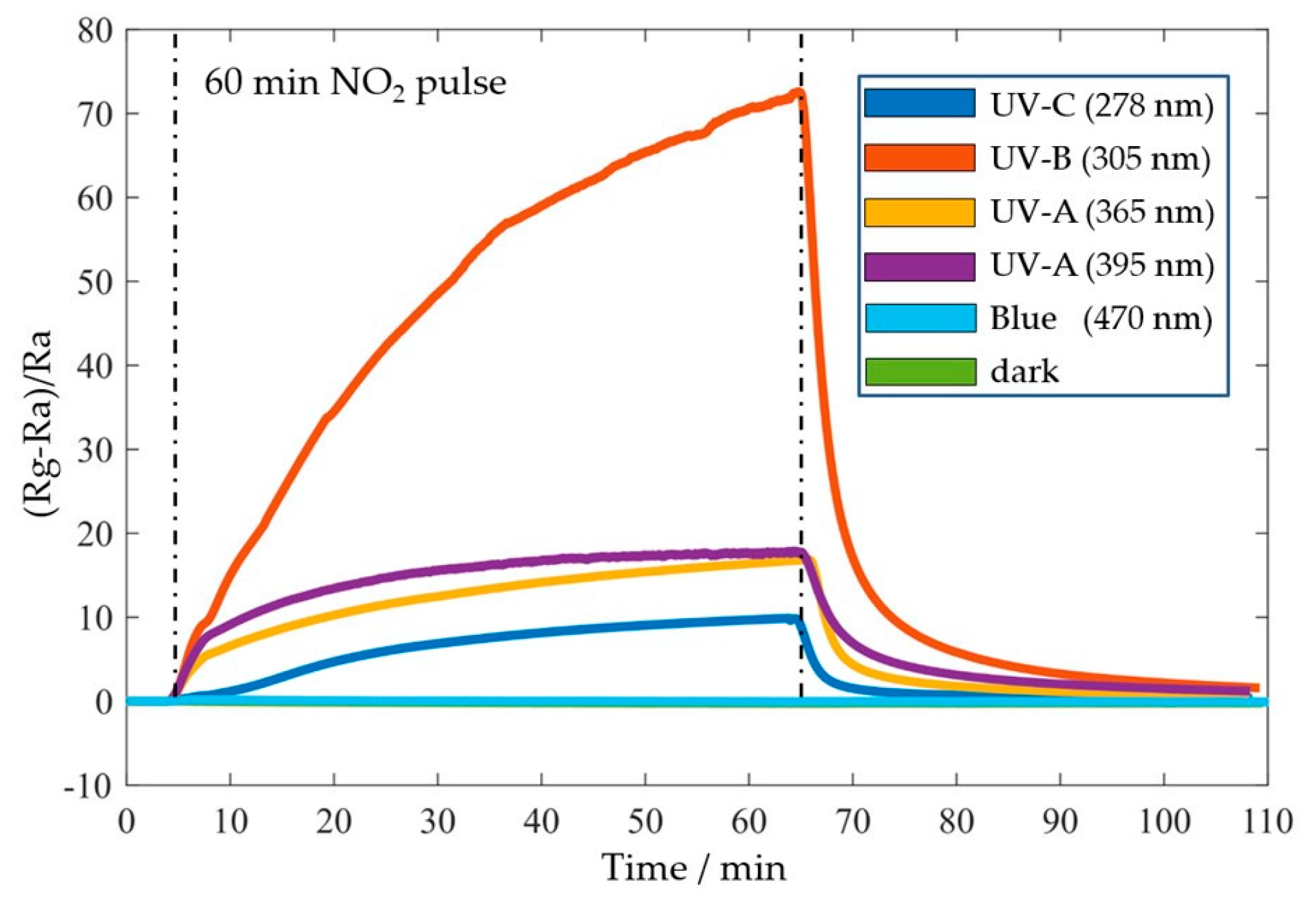UV-LED Photo-Activated Room Temperature NO2 Sensors Based on Nanostructured ZnO/AlN Thin Films †
Abstract
:1. Introduction
2. Working Principle
3. Sensor Fabrication
4. Measurement System and Results
Author Contributions
Acknowledgments
Conflicts of Interest
References
- Fabrega, C.; Casals, O.; Hernandez-Ramirez, F.; Prades, J.D. A review on efficient self heating in nanowire sensors: Prospects for very-low power devices. Sens. Actuators B 2018, 256, 797–811. [Google Scholar] [CrossRef]
- Wasisto, H.S.; Uhde, E.; Peiner, E. Enhanced performance of pocket-sized nanoparticle exposure monitor for healthy indoor environment. Build. Environ. 2016, 95, 13–20. [Google Scholar] [CrossRef]
- Wasisto, H.S.; Merzsch, S.; Uhde, E.; Waag, A.; Peiner, E. Handheld personal airborne nanoparticle detector based on microelectromechanical silicon resonant cantilever. Microelectron. Eng. 2015, 145, 96–103. [Google Scholar] [CrossRef]
- Wasisto, H.S.; Merzsch, S.; Waag, A.; Uhde, E.; Salthammer, T.; Peiner, E. Airborne engineered nanoparticle mass sensor based on a silicon resonant cantilever. Sens. Actuator B 2013, 180, 77–89. [Google Scholar] [CrossRef]
- Zhu, L.; Zeng, W. Room-temperature gas sensing of ZnO-based gas sensor: A review. Sens. Actuators A 2017, 267, 242–261. [Google Scholar] [CrossRef]
- Procek, M.; Pustelny, T.; Stolarczyk, A. Influence of external gaseous environments on the electrical properties of ZnO nanostructures obtained by a hydrothermal method. Nanomaterials 2016, 6, 227. [Google Scholar] [CrossRef] [PubMed]
- Zhang, S.; Lei, T.; Li, D.; Zhang, G.; Xie, C. UV light activation of TiO2 for sensing formaldehyde: How to be sensitive, recovering fast, and humidity less sensitive. Sens. Actuators B 2014, 202, 964–970. [Google Scholar] [CrossRef]




Publisher’s Note: MDPI stays neutral with regard to jurisdictional claims in published maps and institutional affiliations. |
© 2018 by the authors. Licensee MDPI, Basel, Switzerland. This article is an open access article distributed under the terms and conditions of the Creative Commons Attribution (CC BY) license (https://creativecommons.org/licenses/by/4.0/).
Share and Cite
Granz, T.; Temming, M.; Xu, J.; Qomaruddin; Fabrega, C.; Majid, N.; Lilienkamp, G.; Daum, W.; Peiner, E.; Prades, J.D.; et al. UV-LED Photo-Activated Room Temperature NO2 Sensors Based on Nanostructured ZnO/AlN Thin Films. Proceedings 2018, 2, 888. https://doi.org/10.3390/proceedings2130888
Granz T, Temming M, Xu J, Qomaruddin, Fabrega C, Majid N, Lilienkamp G, Daum W, Peiner E, Prades JD, et al. UV-LED Photo-Activated Room Temperature NO2 Sensors Based on Nanostructured ZnO/AlN Thin Films. Proceedings. 2018; 2(13):888. https://doi.org/10.3390/proceedings2130888
Chicago/Turabian StyleGranz, Tony, Marius Temming, Jiushuai Xu, Qomaruddin, Cristian Fabrega, Nurhalis Majid, Gerhard Lilienkamp, Winfried Daum, Erwin Peiner, Joan Daniel Prades, and et al. 2018. "UV-LED Photo-Activated Room Temperature NO2 Sensors Based on Nanostructured ZnO/AlN Thin Films" Proceedings 2, no. 13: 888. https://doi.org/10.3390/proceedings2130888
APA StyleGranz, T., Temming, M., Xu, J., Qomaruddin, Fabrega, C., Majid, N., Lilienkamp, G., Daum, W., Peiner, E., Prades, J. D., Waag, A., & Wasisto, H. S. (2018). UV-LED Photo-Activated Room Temperature NO2 Sensors Based on Nanostructured ZnO/AlN Thin Films. Proceedings, 2(13), 888. https://doi.org/10.3390/proceedings2130888





